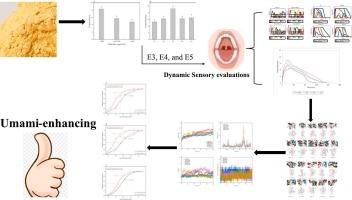Decoding of novel umami peptides from corn fermented powder and its mechanism via multisensory techniques, virtual screening, and molecular simulation approaches
IF 8.5
1区 农林科学
Q1 CHEMISTRY, APPLIED
引用次数: 0
Abstract
This study aimed to identify umami peptides in corn fermented powder (CFP) and investigate their umami enhancing effect. Ultrafiltration and ethanol precipitation was used to separate the umami peptides in CFP. Dynamic sensory evaluations were used to identify the peptide fraction with the intense umami taste, and the peptides in the fraction were identified by nano-liquid chromatography-tandem mass spectrometry. Subsequently, ten umami-enhancing peptide candidates were screened using an integrated virtual screening strategy. Molecular docking revealed that Ser382, Ser104, Leu334, Glu338 and Glu148 of the T1R1 and T1R3 taste receptors are important amino acid residues for binding of the ten umami peptides. Three umami peptides (VDW, WGDDP, and WPAGE) exhibited the stronger binding affinity with the umami receptors. Moreover, molecular dynamics simulation revealed that the T1R1/T1R3 formed stable complexes with the three umami peptides during the simulation. Sensory evaluation indicated that the three peptides exhibited diverse taste characteristics (detection thresholds:0.0315–0.0625 mg/mL). The sigmoid curve analysis further confirmed peptides were identified as synergistically (VDW and WGDDP) or additively (WPAGE) enhancing the umami of 3 mg/mL MSG solution. This study uncovers the mechanism of umami-peptide-driven taste in fermented corn products.

通过多感官技术、虚拟筛选和分子模拟方法解码玉米发酵粉中的新型鲜味肽及其机理。
本研究旨在鉴定玉米发酵粉(CFP)中的鲜味肽,并研究其增强鲜味的作用。采用超滤和乙醇沉淀法分离玉米发酵粉中的鲜味肽。通过动态感官评价确定了具有浓郁鲜味的肽组分,并利用纳米液相色谱-串联质谱鉴定了该组分中的肽。随后,利用综合虚拟筛选策略筛选出了 10 个增强鲜味的候选肽。分子对接发现,T1R1 和 T1R3 味觉受体的 Ser382、Ser104、Leu334、Glu338 和 Glu148 是这十种鲜味肽结合的重要氨基酸残基。三种鲜味肽(VDW、WGDDP 和 WPAGE)与鲜味受体的结合亲和力较强。此外,分子动力学模拟显示,在模拟过程中,T1R1/T1R3 与这三种鲜味肽形成了稳定的复合物。感官评估表明,这三种肽表现出不同的味道特征(检测阈值:0.0315-0.0625 mg/mL)。西格玛曲线分析进一步证实,这三种肽可协同(VDW 和 WGDDP)或相加(WPAGE)增强 3 毫克/毫升味精溶液的鲜味。这项研究揭示了发酵玉米产品中的鲜味肽驱动味觉的机制。
本文章由计算机程序翻译,如有差异,请以英文原文为准。
求助全文
约1分钟内获得全文
求助全文
来源期刊

Food Chemistry
工程技术-食品科技
CiteScore
16.30
自引率
10.20%
发文量
3130
审稿时长
122 days
期刊介绍:
Food Chemistry publishes original research papers dealing with the advancement of the chemistry and biochemistry of foods or the analytical methods/ approach used. All papers should focus on the novelty of the research carried out.
 求助内容:
求助内容: 应助结果提醒方式:
应助结果提醒方式:


